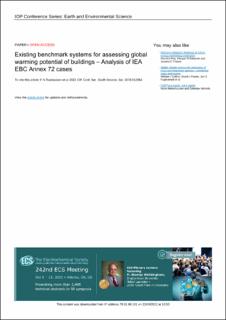| dc.contributor.author | Rasmussen, Freya | |
| dc.contributor.author | Trigaux, D | |
| dc.contributor.author | Alsema, E | |
| dc.contributor.author | Balouktsi, Maria | |
| dc.contributor.author | Birgisdottir, Harpa | |
| dc.contributor.author | Bohne, Rolf André | |
| dc.contributor.author | Dixit, M | |
| dc.contributor.author | Dowdell, D | |
| dc.contributor.author | Francart, N | |
| dc.contributor.author | Frischknecht, Rolf | |
| dc.contributor.author | Foliente, Greg | |
| dc.contributor.author | Lupisek, Antonin | |
| dc.contributor.author | Lutzkendorf, T | |
| dc.contributor.author | Malmqvist, Tove | |
| dc.contributor.author | García Martínez, A | |
| dc.contributor.author | Ouellet-Plamondon, C | |
| dc.contributor.author | Passer, Alexander | |
| dc.contributor.author | Peuportier, B | |
| dc.contributor.author | Ramseier, L | |
| dc.contributor.author | Satola, Daniel | |
| dc.contributor.author | Seo, S | |
| dc.contributor.author | Szalay, Z | |
| dc.contributor.author | Wiik, Marianne Rose Kjendseth | |
| dc.date.accessioned | 2022-09-28T07:44:14Z | |
| dc.date.available | 2022-09-28T07:44:14Z | |
| dc.date.created | 2022-09-19T09:40:40Z | |
| dc.date.issued | 2022 | |
| dc.identifier.issn | 1755-1307 | |
| dc.identifier.uri | https://hdl.handle.net/11250/3022026 | |
| dc.description.abstract | Life cycle assessment (LCA) is increasingly being used as a tool by the building industry and actors to assess the global warming potential (GWP) of building activities. In several countries, life cycle based requirements on GWP are currently being incorporated into building regulations. After the establishment of general calculation rules for building LCA, a crucial next step is to evaluate the performance of the specific building design. For this, reference values or benchmarks are needed, but there are several approaches to defining these. This study presents an overview of existing benchmark systems documented in seventeen cases from the IEA EBC Annex 72 project on LCA of buildings. The study characterizes their different types of methodological background and displays the reported values. Full life cycle target values for residential and non-residential buildings are found around 10-20 kg CO2e/m2/y, whereas reference values are found between 20-80 kg CO2e/m2/y. Possible embodied target- and reference values are found between 1-12 kg CO2e/m2/y for both residential and non-residential buildings. Benchmark stakeholders can use the insights from this study to understand the justifications of the background methodological choices and to gain an overview of the level of GWP performance across benchmark systems. | en_US |
| dc.language.iso | eng | en_US |
| dc.publisher | IOP Science | en_US |
| dc.rights | CC BY 30 | * |
| dc.rights.uri | http://creativecommons.org/licenses/by/3.0/ | * |
| dc.subject | Buildings | en_US |
| dc.subject | LCA | en_US |
| dc.subject | Benchmarking | en_US |
| dc.subject | Global Warming Potential | en_US |
| dc.title | Existing benchmark systems for assessing global warming potential of buildings – Analysis of IEA EBC Annex 72 cases | en_US |
| dc.title.alternative | Existing benchmark systems for assessing global warming potential of buildings – Analysis of IEA EBC Annex 72 cases | en_US |
| dc.type | Peer reviewed | en_US |
| dc.type | Journal article | en_US |
| dc.description.version | publishedVersion | en_US |
| dc.rights.holder | © 2022 The authors | en_US |
| dc.subject.nsi | VDP::Teknologi: 500 | en_US |
| dc.source.volume | 1078 | en_US |
| dc.source.journal | IOP Conference Series: Earth and Environmental Science (EES) | en_US |
| dc.identifier.doi | 10.1088/1755-1315/1078/1/012054 | |
| dc.identifier.cristin | 2052936 | |
| dc.relation.project | Norges forskningsråd: 257660 | en_US |
| dc.source.articlenumber | 012054 | en_US |
| cristin.ispublished | true | |
| cristin.fulltext | original | |
| cristin.qualitycode | 1 | |

